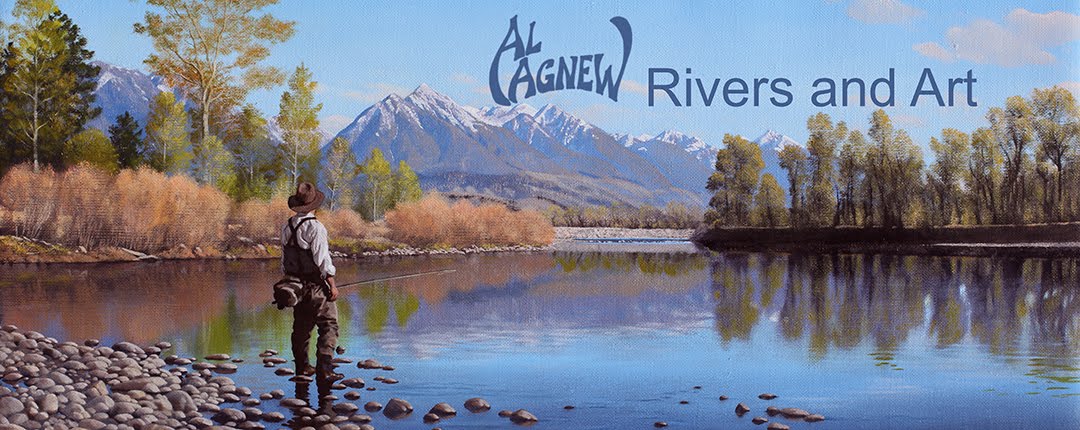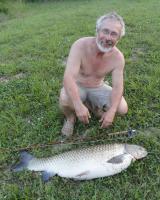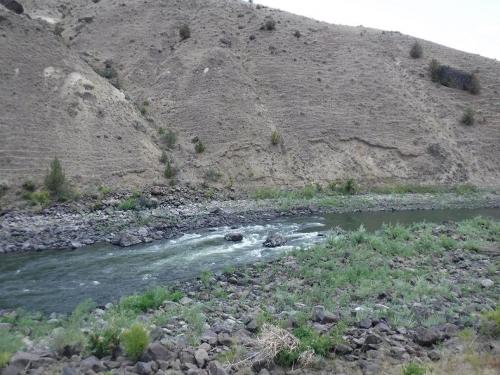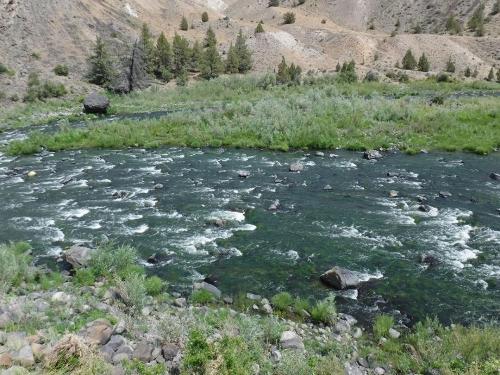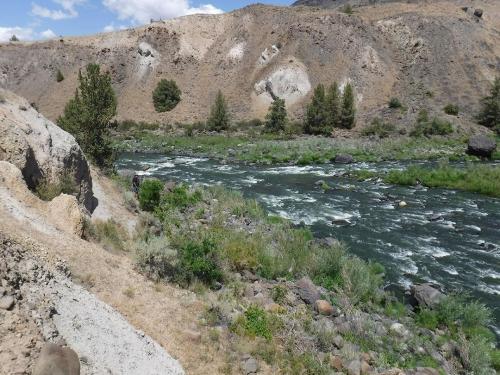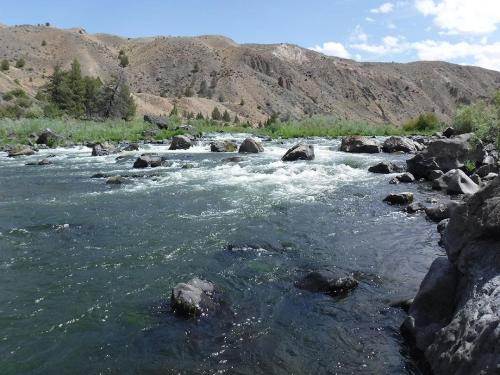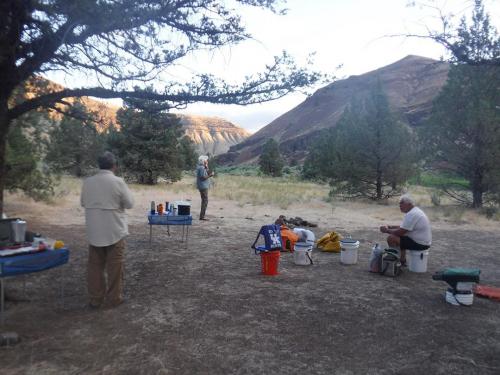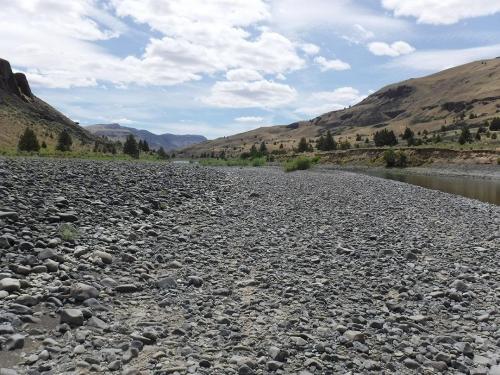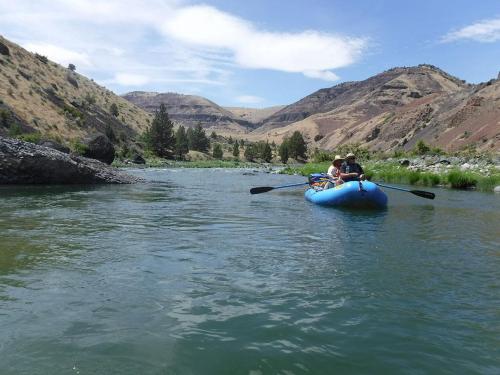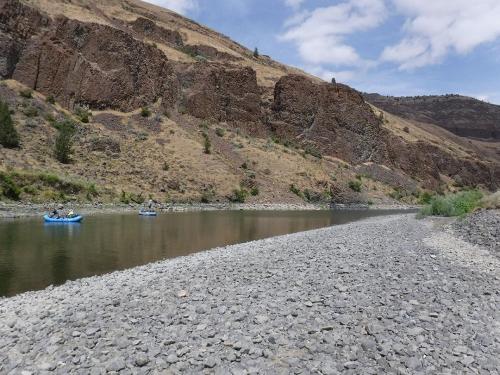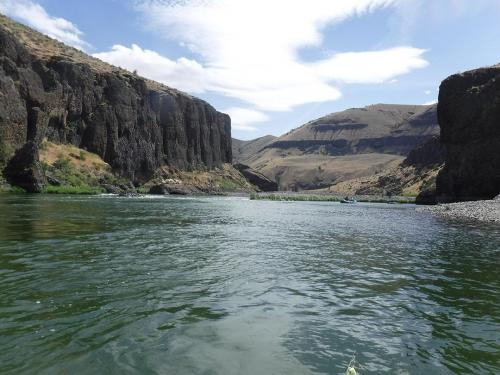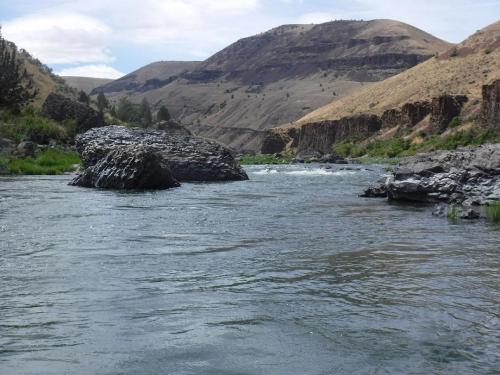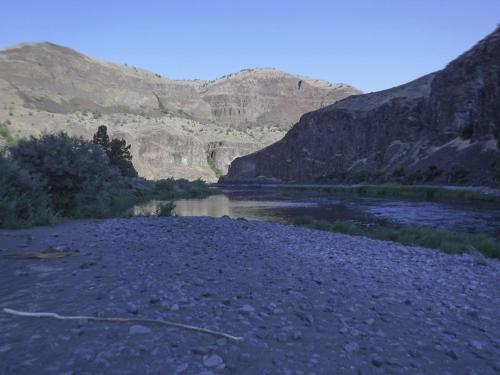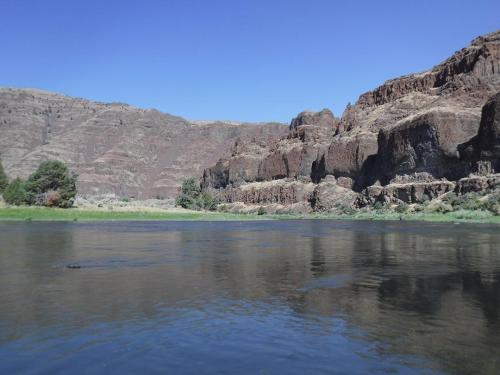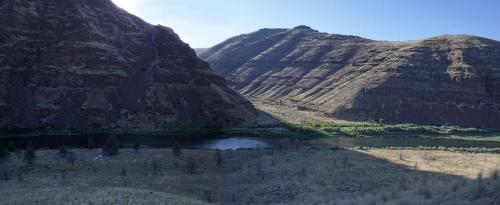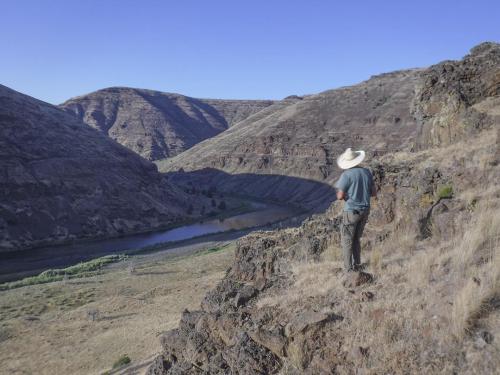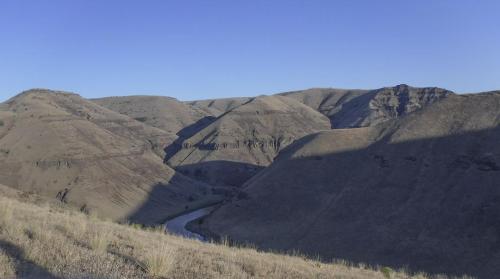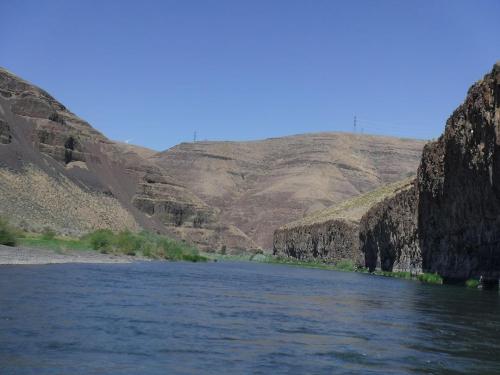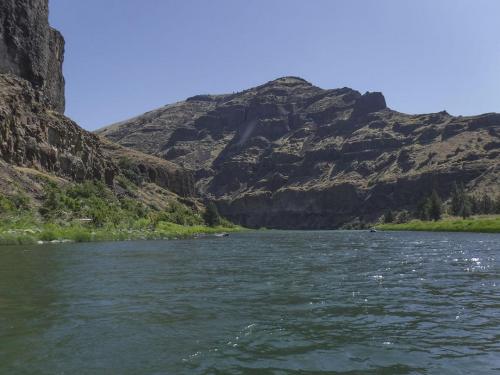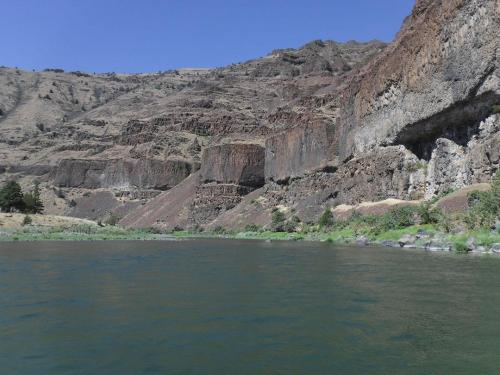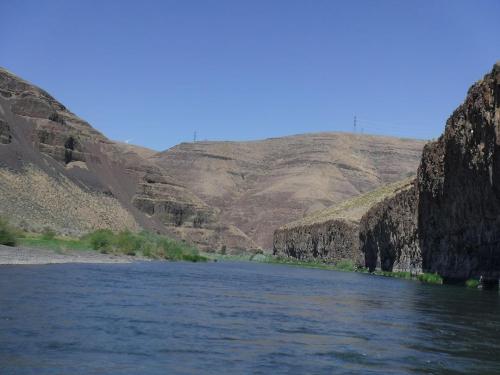For those of us who depend upon the US Geological Survey river gages, the day has finally come when they are switching over to the new format. I had explored the new pages a few times, but was holding off on really diving deeply into the information in them, but today when I clicked on a gage, for the first time the new format appeared instead of the old familiar page.
It is always difficult to switch over from the intimately familiar to something new. And in playing around with the new format, I had not been impressed. There was a lot that seemed to be either missing, or more difficult to reach. But a deeper dive into the information shows that most of what I've used in the past is still available, though some takes a few extra steps to reach.
Most people do not use a tenth of the information these gages contain, anyway. But in fact, most people don't realize how many ways they can be useful, nor do they understand the main pieces of information--gage height in feet, and flow in cubic feet per second. I've been on a bit of a crusade for many years to get people to use the flow in cfs, rather than the height in feet, in determining water conditions. Flow is, quite simply, the volume of water flowing past the gage at any given time. A reading of 20 cubic feet per second is 20 cubic feet of water flowing past the gage each second. It is the same volume, no matter which gage you're reading; a reading of 100 cfs on one gage is the same volume of water as 100 cfs on any other gage. On the other hand, the height in feet is unique to each gage. A reading of 2.5 feet on a given gage is NOT the same as a reading of 2.5 feet on another gage; on one gage it might signify that the river is very low, on another gage, even on the same river, it might show the river at that point is a couple feet higher than normal. So unless you already know what 2.5 feet signifies on a given gage, that number will mean nothing. In other words, the flow in cfs is a universal measurement, but the level in feet is different for each gage. There actually ARE ways in which the level in feet reading can be useful even when viewing a gage on an unfamiliar river, however.
With that in mind, perhaps we're reading to take a dive into the information contained in the new gage format. Note that I'm showing the screen shots from visiting the gage on a laptop; the same images open on my phone as well, but in a slightly different proportion--you will have to do a bit more scrolling to reach each part of the page.
When you open a page, this is the information that immediately comes up:
 The first thing to note is that you can still reach the old style gage from this page; you'll see a spot to click on "legacy real-time page". Who knows how long this will still be available, but it's still a possibility right now.
The first thing to note is that you can still reach the old style gage from this page; you'll see a spot to click on "legacy real-time page". Who knows how long this will still be available, but it's still a possibility right now. Aha! Now we have a button to click on to change the graph from height in feet to "Discharge, cubic feet per second". So one click will change the graph to what I really want to see. It will also make the "display median" button operable. So, clicking on the discharge button and the median button, we get this graph:
Aha! Now we have a button to click on to change the graph from height in feet to "Discharge, cubic feet per second". So one click will change the graph to what I really want to see. It will also make the "display median" button operable. So, clicking on the discharge button and the median button, we get this graph: The graph is now for flow in cubic feet per second, and the median is shown as a dotted line going across the graph. Median is a VERY important piece of information. It is a good approximation of the normal flow for the time period, so we can see in this case that the flow was a bit above normal, even before the rain a few hours ago raised the river slightly.
The graph is now for flow in cubic feet per second, and the median is shown as a dotted line going across the graph. Median is a VERY important piece of information. It is a good approximation of the normal flow for the time period, so we can see in this case that the flow was a bit above normal, even before the rain a few hours ago raised the river slightly. Of this information, median is the most immediately important. Median, as I said before, is a good approximation of what the river normally flows on this date or time of year. It is the flow of which 50% of all recorded flows for the date are lower, and 50% higher. The 25th percentile value is the flow number for which only 25% of the recorded flows were lower, and the 75th percentile is the flow number for which 75% of recorded flows were lower. The mean is the average of all flows recorded for the date. You might think it would be a better approximation of normal than the median, but it is not, because any really high water recorded on the date skews the average upward; the mean is always a significantly higher figure than the median. The lowest value and highest value show the lowest and highest flows ever recorded for the date, and the year in which they were recorded.
Of this information, median is the most immediately important. Median, as I said before, is a good approximation of what the river normally flows on this date or time of year. It is the flow of which 50% of all recorded flows for the date are lower, and 50% higher. The 25th percentile value is the flow number for which only 25% of the recorded flows were lower, and the 75th percentile is the flow number for which 75% of recorded flows were lower. The mean is the average of all flows recorded for the date. You might think it would be a better approximation of normal than the median, but it is not, because any really high water recorded on the date skews the average upward; the mean is always a significantly higher figure than the median. The lowest value and highest value show the lowest and highest flows ever recorded for the date, and the year in which they were recorded. Clicking on "Current/Historical Observations" just takes you back to the new gage page. "Daily Data" actually takes you to something resembling the OLD gage page, but with the default of showing the gage height and flow rate graphs for the last year. You can change the dates and time periods shown if you wish. The graphs:
Clicking on "Current/Historical Observations" just takes you back to the new gage page. "Daily Data" actually takes you to something resembling the OLD gage page, but with the default of showing the gage height and flow rate graphs for the last year. You can change the dates and time periods shown if you wish. The graphs:  There is one more piece of info that I find useful to get from this page. Near the top of the page is a link to "Current stage-discharge rating". Clicking on it, you get this:
There is one more piece of info that I find useful to get from this page. Near the top of the page is a link to "Current stage-discharge rating". Clicking on it, you get this: It may look like gobbledegook, but scroll down past the first part to the three columns of numbers, which will continue farther down the page than shown here. These numbers will take just a bit of explanation...
It may look like gobbledegook, but scroll down past the first part to the three columns of numbers, which will continue farther down the page than shown here. These numbers will take just a bit of explanation... So you can see here that, for instance, a gage height of 2.30 feet (from the column on the left) means the river is flowing an estimated 644.24 cubic feet per second (from the column on the right).
So you can see here that, for instance, a gage height of 2.30 feet (from the column on the left) means the river is flowing an estimated 644.24 cubic feet per second (from the column on the right). It shows the available data being the discharge in cfs for the time period from, in this case, 1922-10-01 to 2022-08-17. Click on the box on that, and then down below, you can make choices on the date range of the data you want to see, and a drop down menu of which table you want to see. The default is "mean", but if you click on the menu it will give you the choices of minimum, maximum, and a bunch of percentiles including "median". We already know that median is far more useful than mean or any of the percentiles. Minimum and maximum will give you the highest and lowest values ever recorded for each day of the time period you select. But, let's select a time period beginning with the earliest data and ending in the latest available, from Oct 01 1922 to Aug 17 2022, and then select median from the drop down menu. Hit "submit", and it gets us this:
It shows the available data being the discharge in cfs for the time period from, in this case, 1922-10-01 to 2022-08-17. Click on the box on that, and then down below, you can make choices on the date range of the data you want to see, and a drop down menu of which table you want to see. The default is "mean", but if you click on the menu it will give you the choices of minimum, maximum, and a bunch of percentiles including "median". We already know that median is far more useful than mean or any of the percentiles. Minimum and maximum will give you the highest and lowest values ever recorded for each day of the time period you select. But, let's select a time period beginning with the earliest data and ending in the latest available, from Oct 01 1922 to Aug 17 2022, and then select median from the drop down menu. Hit "submit", and it gets us this: This is a table of the average median value for every day of the year throughout all the years of record available. In other words, this is a table of what normal flow for the river at the gage site should be on every given day. So if you want to know what the river should normally be flowing on, for instance, March 15th, 555 cubic feet per second is your answer. More interestingly, you can look at this table and see that the river normally flows more water at certain times of the year than others. In April and into May, it normally flows the highest, 500 to well over 600 cfs. While in September and October it will normally flow less than 200 cfs.
This is a table of the average median value for every day of the year throughout all the years of record available. In other words, this is a table of what normal flow for the river at the gage site should be on every given day. So if you want to know what the river should normally be flowing on, for instance, March 15th, 555 cubic feet per second is your answer. More interestingly, you can look at this table and see that the river normally flows more water at certain times of the year than others. In April and into May, it normally flows the highest, 500 to well over 600 cfs. While in September and October it will normally flow less than 200 cfs. Note that over on the left are links to click on for every gage in the state. On the right are figures for "Discharge, ft3/s" (that's what the stream at each gage is flowing presently) and "Long-term median flow (present date)" (that's the median or normal flow for the date). So immediately, you can see what the river is flowing now and compare it to normal. Much of the time, that's all you need to know. For instance, scrolling down the page, which is grouped by major river systems, to the Meramec River system, we get this:
Note that over on the left are links to click on for every gage in the state. On the right are figures for "Discharge, ft3/s" (that's what the stream at each gage is flowing presently) and "Long-term median flow (present date)" (that's the median or normal flow for the date). So immediately, you can see what the river is flowing now and compare it to normal. Much of the time, that's all you need to know. For instance, scrolling down the page, which is grouped by major river systems, to the Meramec River system, we get this: Say I'm wanting to know what conditions are on Big River near Richwoods, because I'm wanting to fish the lower middle river. I can instantly see that the normal flow there is 164 cfs, and it's flowing 190 cfs right now. That's plenty close enough to normal; the river should be in good shape. If weather conditions were stable and there hadn't been any rain in the last day or so, that would be good enough, no need to actually even visit the gage page. I have this page, the streamflow table, bookmarked on all my computers and my phone. All I have to do is click on it, and scroll down to the river I'm interested in, and see if it's near normal or not.
Say I'm wanting to know what conditions are on Big River near Richwoods, because I'm wanting to fish the lower middle river. I can instantly see that the normal flow there is 164 cfs, and it's flowing 190 cfs right now. That's plenty close enough to normal; the river should be in good shape. If weather conditions were stable and there hadn't been any rain in the last day or so, that would be good enough, no need to actually even visit the gage page. I have this page, the streamflow table, bookmarked on all my computers and my phone. All I have to do is click on it, and scroll down to the river I'm interested in, and see if it's near normal or not. Now, here is where the height in feet graph does come in handy. It's showing the river has risen from about 2.75 feet to 4 feet, and may still be rising. That's a rise of over a foot. A good rule of thumb is that a rise of more than a foot is fairly likely to mean a slug of muddy water. So now my fishing trip downstream from there is looking a little more iffy. Maybe I better either go now and hope I can get in some good fishing before the muddy water hits, or else look for a different place to go that isn't quite so chancy.
Now, here is where the height in feet graph does come in handy. It's showing the river has risen from about 2.75 feet to 4 feet, and may still be rising. That's a rise of over a foot. A good rule of thumb is that a rise of more than a foot is fairly likely to mean a slug of muddy water. So now my fishing trip downstream from there is looking a little more iffy. Maybe I better either go now and hope I can get in some good fishing before the muddy water hits, or else look for a different place to go that isn't quite so chancy. You can see that there is no day of the year in which the median was under 100 cfs. So normally, that stretch would not get too low to float easily. If I still wondered if it could get too low during a really bad drought, I might change the drop down menu from "median" to "minimum". This would give me this table:
You can see that there is no day of the year in which the median was under 100 cfs. So normally, that stretch would not get too low to float easily. If I still wondered if it could get too low during a really bad drought, I might change the drop down menu from "median" to "minimum". This would give me this table: See all those values below 100 cfs? So it IS possible for the lower Jacks Fork to get too low for easy floating, but only if there has been a VERY extended drought.
See all those values below 100 cfs? So it IS possible for the lower Jacks Fork to get too low for easy floating, but only if there has been a VERY extended drought.